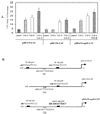Transforming growth factor-beta - and tumor necrosis factor-alpha -mediated induction and proteolytic activation of MMP-9 in human skin
- PMID: 11297541
- PMCID: PMC2651823
- DOI: 10.1074/jbc.M010839200
Transforming growth factor-beta - and tumor necrosis factor-alpha -mediated induction and proteolytic activation of MMP-9 in human skin
Abstract
Both cytokines and matrix metalloproteinases (MMPs) are active during physiologic and pathologic processes such as cancer metastasis and wound repair. We have systematically studied cytokine-mediated MMP regulation. Cytokine-mediated proteinase induction and activation were initially investigated in organ-cultured human skin followed by determination of underlying cellular and molecular mechanisms using isolated skin cells. In this report we demonstrate that tumor necrosis factor-alpha (TNF-alpha) and transforming growth factor-beta (TGF-beta) synergistically induce pro-MMP-9 in human skin as well as isolated dermal fibroblasts and epidermal keratinocytes. Furthermore, TNF-alpha promotes proteolytic activation of pro-MMP-9 by conversion of the 92-kDa pro-MMP-9 to the 82-kDa active enzyme. This activation occurred only in skin organ culture and not by either isolated fibroblasts or keratinocyte, although the pro-MMP-9 activation could be measured in a cell-free system derived from TNF-alpha-activated skin. The cytokine-mediated induction of pro-MMP-9 in dermal fibroblasts was evident by increased mRNA. At the transcription level, we examined the cytokine-mediated transactivation of the 5'-region promoter of the human MMP-9 in dermal fibroblasts. The results demonstrated that TNF-alpha and TGF-beta could independently stimulate the 5'-flanking 670-base pair promoter. A TGF-beta-response element (-474) and an NF-kappaB-binding site (-601) were identified to be the cis-elements for TGF-beta or TNF-alpha activation, respectively. Taken together, these findings suggest a specific mechanism whereby multiple cytokines can regulate MMP-9 expression/activation in the cells of human skin. These results imply roles for these cytokines in the regulation of MMP-9 in physiologic and pathologic tissue remodeling.
Figures











Similar articles
-
TNF-alpha stimulates activation of pro-MMP2 in human skin through NF-(kappa)B mediated induction of MT1-MMP.J Cell Sci. 2001 Jan;114(Pt 1):131-139. doi: 10.1242/jcs.114.1.131. J Cell Sci. 2001. PMID: 11112697 Free PMC article.
-
Tumor necrosis factor-alpha-induced proteolytic activation of pro-matrix metalloproteinase-9 by human skin is controlled by down-regulating tissue inhibitor of metalloproteinase-1 and mediated by tissue-associated chymotrypsin-like proteinase.J Biol Chem. 2002 Jul 26;277(30):27319-27. doi: 10.1074/jbc.M202842200. Epub 2002 May 9. J Biol Chem. 2002. PMID: 12004062 Free PMC article.
-
Interleukin-1alpha-induced proteolytic activation of metalloproteinase-9 by human skin.Surgery. 2005 Nov;138(5):932-9. doi: 10.1016/j.surg.2005.05.003. Surgery. 2005. PMID: 16291395 Free PMC article.
-
Transforming growth factor-beta suppresses tumor necrosis factor alpha-induced matrix metalloproteinase-9 expression in monocytes.J Leukoc Biol. 2001 Apr;69(4):613-21. J Leukoc Biol. 2001. PMID: 11310848
-
Tumor necrosis factor-alpha-stimulated membrane type 1-matrix metalloproteinase production is modulated by epidermal growth factor receptor signaling in human gingival fibroblasts.J Periodontal Res. 2009 Feb;44(1):73-80. doi: 10.1111/j.1600-0765.2007.01081.x. J Periodontal Res. 2009. PMID: 19515020
Cited by
-
The relationship between the MMP system, adrenoceptors and phosphoprotein phosphatases.Br J Pharmacol. 2012 Jun;166(4):1225-43. doi: 10.1111/j.1476-5381.2012.01917.x. Br J Pharmacol. 2012. PMID: 22364165 Free PMC article. Review.
-
Multimechanistic antifibrotic effect of biochanin a in rats: implications of proinflammatory and profibrogenic mediators.PLoS One. 2013 Jul 16;8(7):e69276. doi: 10.1371/journal.pone.0069276. Print 2013. PLoS One. 2013. PMID: 23874933 Free PMC article.
-
The interferon-gamma-induced GTPase, mGBP-2, inhibits tumor necrosis factor alpha (TNF-alpha) induction of matrix metalloproteinase-9 (MMP-9) by inhibiting NF-kappaB and Rac protein.J Biol Chem. 2011 Jun 3;286(22):20054-64. doi: 10.1074/jbc.M111.249326. Epub 2011 Apr 18. J Biol Chem. 2011. PMID: 21502320 Free PMC article.
-
Transforming growth factor-β1 induces matrix metalloproteinase-9 and cell migration in astrocytes: roles of ROS-dependent ERK- and JNK-NF-κB pathways.J Neuroinflammation. 2010 Dec 6;7:88. doi: 10.1186/1742-2094-7-88. J Neuroinflammation. 2010. PMID: 21134288 Free PMC article.
-
Matrix metalloproteinase (MMP) and TGF beta 1-stimulated cell migration in skin and cornea wound healing.Cell Adh Migr. 2008 Oct-Dec;2(4):252-3. doi: 10.4161/cam.2.4.6772. Epub 2008 Oct 11. Cell Adh Migr. 2008. PMID: 19262153 Free PMC article.
References
-
- Leibovich SJ, Polverini PJ, Shepard HM, Wiseman DM, Shively V, Nuseir N. Nature. 1987;329:630–632. - PubMed
-
- Garner WL, Karmiol S, Rodriguez JL, Smith DJ, Jr, Phan SH. J. Invest. Dermatol. 1993;101:875–879. - PubMed
-
- Cooney R, Iocono J, Maish G, Smith JS, Ehrlich P. J. Trauma. 1997;42:415–420. - PubMed
-
- Kitzis V, Engrav LH, Quinn LS. J. Surg. Res. 1999;87:134–141. - PubMed
Publication types
MeSH terms
Substances
Grants and funding
LinkOut - more resources
Full Text Sources
Miscellaneous

